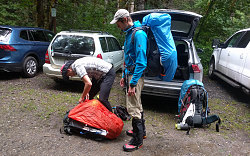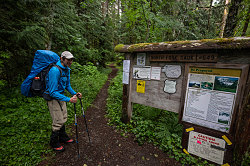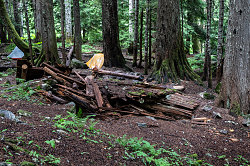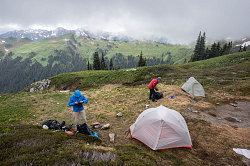Volcano Quest III : Glacier Peak
Day 1 : A Wet Start - Thursday, July 18
We got up nice and early, well before sunrise, and headed out of Seattle. Along the way, we stopped at the Starbucks in Arlington, WA that has become a somewhat regular thing on these Glacier Peak attempts, where Rosty gets his must-have morning coffee. From there, we drove under a partly cloudy sky that became overcast and then, as we drove south through the increasingly large mountains near Darrington, misty and wet. We turned onto the gravelled backway known as the "mountain loop" highway, a partially-paved, partially-gravelled highway that cuts through a small chunk of the Western Cascades.

NF-49
After travelling south for a while on the Mountain Loop highway, we turned left onto a small, twistier forest road, NF-49. Another 20-30 minutes of driving brought us to the North Fork Sauk [River] trailhead - starting point for several area outings but most importantly for us, the start point of trail #649, the North Fork Sauk River Trail. This trail leads east, up the forested valley of the North Fork Sauk River, and then up into the high country along the Pacific Crest Trail.
Briefly speaking of our route, it was the same as the previous two tries: hike in on the North Fork Sauk R. Trail, then to White Pass, then north on the semi-official Foam Creek trail almost to its end, then following a herdpath/cross-country route, wind our way north through various alpine basins to a high saddle below Glacier Peak's southern ridgeline. Then up the ridgeline, onto some fairly easy Glaciers, then steeply up to the highest summit bump. And then all the way back again.

courtesy BConnell
There were a surprising number of cars here at the trailhead for a Thursday. At least I thought so based on the number of cars that had been here on our previous two visits. Maybe the weather had been bad for a while, and this was a sort of pent-up response.
Yeah, so about that forecast. We had checked at the last minute, once again. Forecast for today: rainy in the morning, trending towards dryness later in the day. Tomorrow: partly cloudy, trending towards clear. Saturday: clear clear clear, Sunday: clear clear clear. We were happy to trade wetness today for clarity on Saturday (our most likely summit day).
And so, with a light drizzle falling and with raincoats and pack covers on, we set out on our third attempt to climb Glacier Peak. Volcano Quest III was fully underway!

North Fork trail #649
We started off shortly after 8 in the morning, giving us plenty of time to get to several reasonable camp locations. It was even not outside of the realm of possibility to get to the high camp below the summit today, although that would be pushing it - and in any case we needed to allow a bit of time for the current weather conditions to clear out.
Having been up and down this route twice before in the last four years, we were pretty familiar with the trail. We weren't tired of it, though, because it leads through such beautiful old-growth forest (or at least what seems like old-growth to me). Initially flat, the trail's environs were almost like a manicured garden: huge mature trunks disappearing into the canopy above, verdant ferns and other moisture-loving plants carpeting the ground on both sides of the trail. Moss covered boulders; carefully dug drainage ditches, log bridges, and planking.
The valley component of the North Fork Sauk River trail climbs 900 feet - which may seem like a decent amount, until you realize that that is over a distance of nearly 10 kilometers (6 miles), meaning the grade is very gradual. There are a few spots which definitely felt like "real" uphill, but for the most part the trail is experienced as a fairly flat affair, or at the very least you only notice that it undulates a bit up and down over small rises and dips (cumulatively, though the ups are bigger than the downs). Not all of this long approach is through most-beautiful-forest type scenery, but a lot of it is very nice. very nice.
With a gentle grade and almost perfect footing everywhere, it's easy to make very good time on this trail, even with a backpack on, and this we did - covering the 10km/6mi in about two and a half hours. Along the way we saw a very large national forest trail crew, complete with a big mule train laden with gear. It is impressive that an area that is not even national or state park status can receive that level of trail maintainence resources. One clear sign of that maintenance was the trailside brush that had clearly been recently manicured. On previous visits to this area, we'd found that when the trail crossed open avalanche scars, bushes had been encroaching on the trail, which is troublesome to push through and is especially annoying if there is the least bit of wetness (because it will get you and all of your stuff thoroughly wet, even if it isn't raining). This year, nearly every inch of the trail had had all of the brush clipped back, and clipped back very thoroughly. Travelling through the avalanche scars was a breeze now.
As mentioned already, it took us about two and a half hours to cover the section of the trail that runs in the bottom of the valley - before the point at which it starts climb out. Just before this point is a spot called Mackinaw Shelter - so named because of the rickety old wooden lean-to / shelter that exists there (for campers to use). Turns out that the Mackinaw Shelter is now no more. Instead, a pile of wooden rubble is all that remains. I wonder if it came down on its own, or did someone pull it down deliberately because it was becoming too unstable... In any case, now campers here will have to camp the more modern way, with tents (there are plenty of decent tent sites scattered about the forest here, along with an open-air pit toilet).
I had opted to not wear my mountaineering boots on the stretch in to this point, instead choosing to wear some much more comfortable light hikers and having the mountaineering boots strapped to my pack. Now that we were about to ascend into the alpine, I wanted the extra support of the mountaineering boots (and of course, up in the snow and ice at the higher elevations, they were mandatory). I wrapped my light hikers in a plastic bag and stowed them in the rubble of the Mackinaw Shelter, for later retrieval in a few days on the way out.

Shelter no more
After having a good long break and a mid-morning food/energy refuel, we began the next phase of the day's hike: the ascent up to White Pass. This is where things get a bit more serious. Where we had just done a very gentle rise of 900 feet over 6 miles, we were now about to gain 3000 feet in less than 2.5 miles. Fortunately, this isn't like Eastern North America, where steep nearly automatically equals very rough. Instead, the trail began a very measured (steep, but measured) ascent, up carefully laid-out switchbacks and with a general minimum of uneven-ness. At first we hiked uphill entirely in the forest, but once in a while we'd cross out into the brushy expanse of an avalanche scar. As we ascended, these became more frequent and the areas of forest became less frequent.
Into open Avalanche Scars
The drizzle had stopped by the time we had reached the Mackinaw Shelter (er... ex-shelter). Furthermore, as we ascended, bright spots began to appear and the clouds started to show some holes. Even a touch of blue here and there. And although clouds still enveloped the highest peaks around us, mostly the visibilty to distant terrain was good. So far, it appeared that the weather conditions were tracking properly to the forecast.
Carrying fifty pounds and having to ascend 3000 feet, we took it slow and steady, stopping at least briefly at each 250 feet of elevation gain.
We re-caught up to the trail crew's mule train at about 5100 feet. They had apparently been headed up to White Pass but a trail scout ahead of them had indicated that one little spot along the trail still had a finger of last winter's snow across it that the mules would not be able to cross. They were therefore readying to turn around and head back down to the Mackinaw Shelter.
Good View of the Countryside
We had now reached the top of the trail's switchbacks, and from here, we got to hike the best part of the North Fork Sauk River trail: the beautiful alpine traverse across the valley's upper slopes to White Pass. Now no longer steep, the hiking is not strenuous and the views are nearly continuous. The trail winds in and out of little drainages that cut deeply down the valley slopes.
Slopes south of White Pass
Shortly before 3pm, we intersect with the famous Pacific Crest cross-continental trail, and shortly after 3pm, we arrive at White Pass. This was the first of one of several places we were considering camping. However, it wasn't too late in the day, the weather was looking pretty good, and we had some energy left. So, we decided to continue on. The more ground we covered today, the easier and more relaxed we could be on our second day.
We leave the Pacific Crest Trail at White Pass and head north/east along a fainter, clearly less-traveled trail. We've crossed over from the North Fork Sauk River drainage into the next basin to the north - one that drains the White River. The trail we're on is called the Foam Creek trail, and it will take us north and east until we leave it and start the off trail / cross-country portion of our climb.
Not so much blue any more
All is good as we hike briskly along the Foam Creek Trail (which, like the upper part of the North Fork Sauk River trail, is across beautiful open meadow slopes). As we hike, however, the clouds regather and darken. In fact, it gets downright gloomy overhead. Off to the east we can still see sunlight playing over the slopes, but over top of us, it looks anything but happy.
We quicken our step as we begin to feel a few sprinkles of rain. We talk as we hike, thinking about how far we really want to continue today if the weather is going to turn. After a bit more discussion, we agree that since we've already come a more than reasonable distance, the safest thing to do is find a camping spot sooner and avoid having to hike in a possible rainstorm.
Brian's Alpine Wanderings
I keep searching for flat spots and finally find one just down off the trail right at the spot where the off-trail route begins. Rosty and Brian are good with it and we hurriedly put up the tents in the now-light drizzle and blustery wind that has come up. We have our little impromptu camp set up shortly after 5pm. Good thing that we did it all quickly, too, because it was now raining more steadily. We had saved a bunch of stuff from getting wet. It was cold now, too... brr, and in fact, there was now SLEET mixed in with the rain. Out came the winter clothing!

Camp before the rain
We stood around having our freeze-dried dinner and discussed the trip so far. We were in a decent position to make an easy push to Glacier Gap (the spot from where we planned to start our summit climb) the following day. We were a bit concerned about this turn in the weather, though: the forecast had not called for it, and that shook our belief in its overall accuracy. Was some jinx of the mountain conspiring to turn what was an excellent forecast into yet another Volcano Quest weather disaster?
Ok, so that's it for day 1. Have a quick gander at this video re-cap of the day:
Glacier Peak Climb Day 1 - Re-cap Video
Interactive trackmap with photo points - Glacier Peak Climb, Day 1 - click map to view
Glacier Peak South Route Day 1 - Climb Data
Start Time:
8:17a.m.
End Time:
4:22p.m.
Duration:
8h5m
Distance:
17.05 km
(10.59 mi)
Average Speed:
2.1 km/hr
(1.3 mph)
Start Elevation:
2089ft
(637m)
*
Max Elevation:
6338ft
(1932m)
*
Min Elevation:
2069ft
(630m)
*
End Elevation:
6320ft
(1926m)
*
* : +/- 75 feet
Total Elevation Gain:
4305ft
(1312m)
*
Total Elevation Loss:
54ft
(16m)
*
* : +/- 75 feet
Elevation Graph
